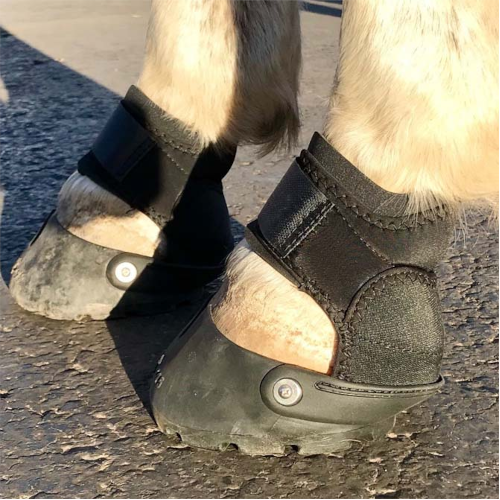Measuring for Easyboots
It is important to match the width and length of the hoof to the Horse Boot size. The front hooves of most horses tend to be more round and wider than the hind hooves. The best fit may require a smaller size for the hind.
How to get the correct size boot for your horse:
After a fresh trim
-Measure the width of the hoof across the bottom at the widest point.
-Measure the length of the hoof from the toe to the buttress line of the heel.The buttress line is the farthest weight bearing point of the heel.
-Compare your measurement with the proper size chart
Ideally, the width and length measurement will fit into the same Horse Boot™ size. If the width and length measurements indicate different sizes, select the larger size.
Proper Hoof Measurement:
If the foot is dirty or you have trouble visualizing the butress line, the bottom of the foot can be lightly rasped or brushed until the hoof wall is clear. The ideal situation is where you can get 2 measurements, one before and one right after trimming. This will tell you how much growth to expect between trimmings.
Measuring Length:
Generally speaking, the length is the most important measurement when booting, and the mesurement that is most often misunderstood. A horse is measured from the toe to the butress line, which is the last weight bearing surface of the foot, where the hoof wall ends. A ruler should be placed at the toe, and run straight down the center of the hoof. If the heel bulbs are included in the measurement, the boot will be much too large.
If you plan on using the boot over the shoe, you should measure to the back of the shoe.
Measuring Width:
The widest part of the foot should be measured, straight across the hoof. Sometimes this is forward or behind the centerline. If the foot is chipped badly, estimate where the hoof should be.
If the horse is between sizes, go with the larger size.
Beacuse every boot size has a different shape, there are instances where some boots fit better than others. Easyboots, Epics and Boas fit a more elongated, oval foot, where Old Mac's are often better for rounder, shorter feet.
We do not recommend the boots if:
-They choose Old Mac's and the hoof width is one or more sizes larger than the length OR the length exceeds the width by more than 4 sizes.
-Boa's, Easyboot or Epics are chosen and and the width is one or more sizes larger than the length OR the length exceeds the width by 2 or more sizes.
Common misconceptions about sizing:
1) Horse boots are sized about the same as horseshoes.
This is incorrect.Horse boots vary greatly and each requires an accurate measurement of the foot. Most boot sizes have a fixed length and much of the measurement is based on length rather than width.
2. Length is measured from the toe to "That part that I can see at the end of the foot" (the bulb).
Length is measured from the toe to the butress line. Including the bulb will cause a boot to be much too large.
3. Every foot is the same size, so I'll just measure one foot
It is not unusual to have the hind feet be one size smaller than the front feet, or the front feet to be slightly different than each other. Each foot that is booted needs to be accurately measured.
4. I can just trace my horses feet to get an accurate measurement
It is better to pick up the foot and measure with a ruler than to take a tracing. A tracing usually adds at least 1/8" to the measurement (which could put you into another boot size) and many people trace around the heel bulbs which makes the measurement very inaccurate.
5. If my horse wears a #1 Easyboot, he will wear a #1 Boa.
Every boot is sized differently.









